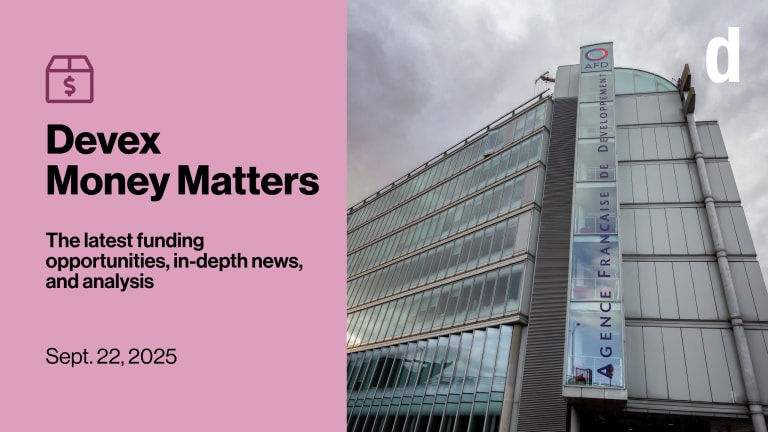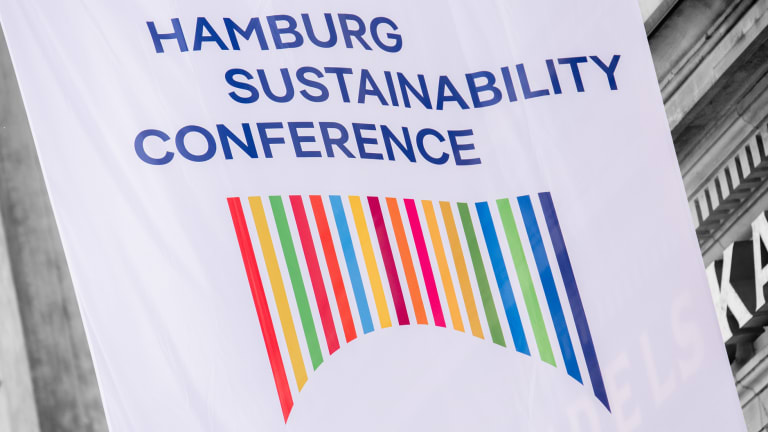
Devex offices are closed this week for a summer break, so instead of the regular Newswire, we’re bringing you in-depth analysis on some of this year’s key development topics. Today, we dive into pandemic preparedness among global and regional health agencies, including funding and replenishment models.
When COVID-19 hit, nations around the world scrambled for access to lifesaving tools to protect their citizens and curb the disease’s spread. The needs were enormous, but many countries lacked the capabilities and resources to respond.
Somalia, for example, had to ship patient samples to Kenya to test for COVID-19 in the early months of the pandemic.
Meanwhile, the international COVAX initiative — which was set up to ensure equitable access to COVID-19 vaccines — faced severe underfunding. This hampered its ability to secure doses from manufacturers amid hoarding by many high-income countries for much of 2021 — which in turn led to delays in vaccine access across many low-resource settings.
And when COVAX eventually got the money to purchase doses, its next challenge was finding additional resources to roll them out in countries and get shots into people’s arms.
Various efforts now seek to address these global inequities and inadequacies, with the goal of better preparing the world for the next pandemic. The question is, where will the money come from?
A new pandemic preparedness fund — housed at the World Bank — is in the works, and the Africa Centres for Disease Control and Prevention is working on its own epidemic fund as it looks to take a bigger role in health emergencies on the continent. The World Health Organization, a key part of the global health architecture, is preparing for a possible increase to its core budget and exploring the feasibility of having its own replenishment, too.
WHO’s next
At the 75th World Health Assembly in May, countries adopted recommendations to provide more flexible funding to WHO, including a potential increase in dues from member states within eight years.
Several experts called the move “historic,” but here’s the catch: The requested boost in dues is an aspiration, rather than an obligation. The real test will take place at next year’s World Health Assembly, when the first proposed increase in dues will be put on the table for the 2024-2025 biennium.

Several experts are optimistic that this will happen. And even if it does, WHO will still need other flexible funding sources to pay for its work.
That’s why the WHA also agreed for the agency to consider adopting a replenishment mechanism. But can WHO pull it off? I recently spoke to experts who said that some of WHO’s specific strengths might play into a potential replenishment. They added that the agency could also learn a few things from the Global Fund to Fight AIDS, Tuberculosis and Malaria and the Global Partnership for Education — both of which have their own replenishment models.
Read: What WHO can learn from different replenishment models (Pro)
+ Sign up for a free 15-day trial of Devex Pro to access all our essential news and analysis, funding insights, invite-only events, and more.
And ICYMI: Countries agreed to sustainable financing for WHO. What's next?
A FIF dream
In June, the World Bank approved a financial intermediary fund for pandemic prevention, preparedness, and response. Shabtai Gold and I have reported on all the important details — including the unknowns, such as whether civil society will have a seat at its governance table as an equal voting member.
What’s certain is that U.N. agencies and multilateral development banks will be the fund’s implementers, which means countries won’t have direct access. Other implementing organizations under consideration are the Coalition for Epidemic Preparedness Innovations, the Global Fund, and Gavi, the Vaccine Alliance.
However, this has been criticized by many civil society groups, which argue that they and regional organizations such as Africa CDC should also be included as implementing agencies.
The fund has so far secured about $1.3 billion in pledges from several bilateral and multilateral donors, as well as philanthropic organizations like Wellcome and The Rockefeller Foundation. But that’s just 12% of the $10.5 billion needed annually. The World Bank hopes the initial pledges will “crowd in” more donations.
All you need to know: How a new pandemic preparedness fund at the World Bank could work
Open the Gates
The Bill & Melinda Gates Foundation, which plays an outsize role in global health philanthropy, has pledged $15 million to the new FIF. And last month, the foundation announced that it would increase its annual giving by 50% within four years.
That means the foundation will soon give out $9 billion annually — with global health being one of the sectors to benefit — as opposed to its current yearly payout of around $6 billion. Bill Gates is adding $20 billion to the foundation’s endowment to help make that happen.
Read: Gates Foundation to increase annual giving by 50% as global crises grow
Plus: Gates Foundation's top 10 health grant winners (Pro)
News you can use
Considering a future in the global health sector? Devex Careers Editor Justin Sablich asked professionals in the field about the most important skills and qualifications you’ll need to get ahead.
Read: 5 things to know if you’re pursuing a career in global health (Career)
+ A Devex Career Account membership includes all the valuable tools you need to be successful in your globaldev job hunt. Sign up today and start your 15-day free trial.
Quicker responses in Africa
After African countries struggled to gain early access to COVID-19 vaccines, the African Union and Africa CDC stepped in to secure doses independently. Now, those institutions are aiming to take a leading role in the continent’s response to similar crises in the future — but some of the bigger players in global health are pushing back.
What happened: Last month, the African Union executive council approved a revised statute for Africa CDC, making it an autonomous public health agency. This gives the institution more independence in responding to health emergencies in the region.
Africa CDC, which was only 3 years old when the pandemic hit, played a crucial role in coordinating the regional response, from providing countries with guidance to helping the continent obtain lifesaving medical equipment.
Why this matters: With its new autonomy, Africa CDC expects to respond faster to outbreaks affecting the region. It can officially declare emergencies of concern to the continent, and it can report on outbreaks directly to government leaders instead of going through the AU.
The pushback: My colleague Sara Jerving has an exclusive report on WHO’s objections to this newfound authority, which overlaps with functions that the global agency already performs.
What’s next: In February, African heads of state supported the establishment of an epidemic fund for the continent, and there is already an “advanced draft” for this fund, which Africa CDC is expected to soon submit to the AU’s Permanent Representatives Committee and other policy organs. This draft will likely be submitted to the executive council for approval at the AU’s annual summit of African heads of state next year.
Read: How Africa CDC's newly approved autonomy can actually happen (Pro)
Want to know more? Read on
• Pandemic preparedness panel says reforms 'slow,' 'stuck' on process
• Africa CDC urges countries to set up centers for health emergencies
• WHO 'certainly don't have enough money' for health emergencies program
• Senegal nears completion of 'bespoke' vaccine manufacturing facility (Pro)
Sign up to Newswire for an inside look at the biggest stories in global development.








